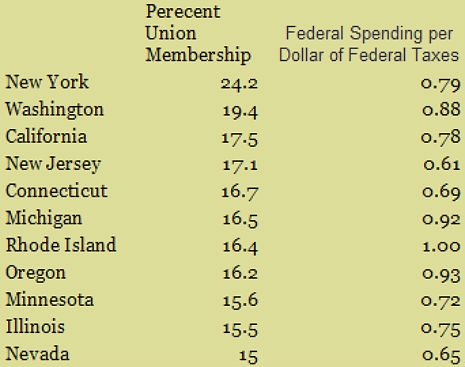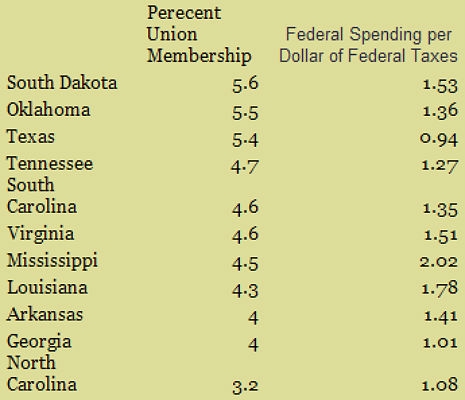
This is a guest editorial from Dangerous Minds reader Em, expanding on some pointed commentary he’s made elsewhere on this blog. Em—who’ll keep his last name to himself, thank you very much—works in the financial industry:
I guess in every country you can find large numbers of people that truly believe something that just isn’t true. The US is special, however, in that we seem quite capable of believing things that are not only directly contrary to the truth, but that would actually result in the self-destruction of the very proponents of those ideas if they were allowed to completely run amok in our social, economic or political policies. Worse than this, the proponents of those same self-destructive policies will often demonize those that oppose them, applying a host of labels that they often successfully get to “stick” with surprising tenacity. Thus, people concerned with global warming are “liberals,” those proposing that a public health option should be made available are “socialists,” and those wanting a better break for the unions are often just labeled out-and-out communists. Sometimes, the vitriol and rhetoric are just so damned ignorant and self-defeating that you are tempted to turn tail and head back to the UK or elsewhere in Europe where things may not be perfect… but at least they are on average rational.
Of all of the issues out there that have gotten turned around and completely distorted, there’s one issue that, the more you look at the numbers and the facts, the more quickly you’ll move from angry laughter through bitter rage and then into sheer seething disgust. In a nutshell, that issue is the impact that the unions have had on federal taxes and which states are net receivers of federal tax money, and which are net donators. Playing with some numbers, I stumbled upon a fact that I suppose some economist out there somewhere must know, but that I’ve never seen mentioned. It is in my mind, at least, shocking, but before I go there let me remind us of a few basics, hum?
One interesting fact that some people are aware of is that the Red States (ie, those that tend to vote Republican) are almost invariably debtor states or (as I like to call them) hobo states, in that they take more federal funds than they deliver in taxes each year. You know the states –Georgia, North and South Carolina, Virginia, Tennessee, New Mexico, Arizona and so on. These are the states always looking for (and getting!) a handout and yet where citizens are famous for declaring themselves “proud” and “self-reliant.” Conversely, the Blue or donor states (New York, California, Massachusetts, Illinois, Wisconsin, Minnesota, Oregon and so on), these are the states that pay more in taxes to the federal government that they receive. These states tend to vote Democrat in presidential elections.
On the surface, of course, it certainly looks like the Red States vote Republican in order to pump tax money out of the Blue States into the hobo states’ hungry coffers. That much has been commented on by many and analyzed in fascinating detail by sources such as this one.
But I got to asking myself: What precisely, is the real source of wealth in the Blue States? Why is it that these states have so much extra cash that they can afford to be net donators of federal money to the Red States? And why are the Red States invariably in need of a handout? One could, of course, do some complex analysis around the concentration of big industries in certain areas, or perhaps look at per capita wealth concentration and then try to piece together some larger picture out of countless details. A bigass computer simulation wouldn’t seem inappropriate in this context.
Or it could be something far simpler than that. Anyone who has read my pieces on Dangerous Minds will know that I’ve been ranting about how the middle class is actually the engine of job creation and that one critical means by which the middle class has in effect been “capitalized” is through the unions and union wages. Looking across the pond, it’s no mistake that some of the most highly unionized countries in the world (Germany and Sweden) were in effect able to fund the bailout of the near-collapse of the EU. In other words, in countries like Germany and Sweden the middle class actually have money, and this disposable income in the hands of the many has a multiplicative effect on wealth creation.
So the question becomes: Is it true here in the US? In other words, could it possibly be that the main reason the donor/Blue States have extra cash with which to provide the Hobo/Red States with what is in effect a perpetual bailout is that the Blue States are more heavily unionized? At this point, the answer shouldn’t come as a surprise, but what did come as a surprise to me at least, was just how extreme the differences are. Consider the following table I generated showing the top 11 states in descending order of union membership matched with their federal tax outlay ratio. In other words, New York State is the most highly unionized state in the lower 48, followed by Washington and California and so on.

See that column on the right? That’s the ratio of federal tax dollars received to those paid. In other words, for every dollar of Federal taxes paid by residents of New York, they receive a mere 79 cents. What is hilarious is that the top 11 most-Unionized states happen to be the states that receive the least in Federal tax benefit compared to what they pay. In other words, the union states are the wealthy donor states. That these states have a surplus is obviously due to the increased wages of the unionized themselves, but also because of all the additional spending driven by disposable income. Perhaps more importantly, new jobs will be created in the donor states as some union employees attempt to strike out on their own and become suppliers to the industries in which they were employed.
How about at the bottom? You got it. Here’s a table of the least unionized states in the US, with their corresponding federal tax ratio:

With the notable (though marginal) exception of Texas, 10 of the 11 least unionized states in the lower 48 happen to be those that eat the most in federal tax money compared to what they pay. Is this surprising? Maybe. But if you’ve paid any attention to all of the anti-Union rhetoric that has always flown around, then you will not only be surprised but disgusted. Some of these hobo states are precisely the ones that have launched persistent, long-term attacks on their unions.
More than the rhetoric, though, are the implications. The right has always proclaimed that unions kill wealth by pulling capital out of the hands of the wealthy, who have some innate and God-given talent to create more wealth and jobs. But what we see here is precisely the opposite: By pulling wealth out of the middle classes that they receive in the form of union wages, the rich inhabitants of those Hobo states have by no means made up the tax difference. In fact, they have converted their state into a hobo state, that the working unionized people in the Blue States must be taxed to support. Put in another way, every time a union is disbanded or disempowered in one of the hobo states, those of us living in the Blue States must in effect shell out more in order to cover their increasing tax gap.
At this juncture it may be worth comparing union membership to the other method of redistributing wealth: Taxation schemes. While in the short run increasing taxes on the wealthy will almost certainly be necessary in order to make a dent in the huge national deficit, what this analysis points to is that the real, “private” method of income redistribution is through the unions, where there is no Federal middleman. In other words, if we consider middle class capitalization as a necessary prerequisite for wealth creation, then the “left wing” method would be through taxation, but the right should consider union membership as the “private” non-governmental solution to the same problem.
An easy solution, therefore, presents itself: Examining the data across all 48 states, we can fairly easily assert that the breakeven level of union membership in a state (ie, for them to convert from a hobo state to a donor state) is somewhere between 10% to 15% of union membership. So how about this: Let’s push for a law that prohibits net Federal money from flowing into states with anything less than 10% union membership. Problem solved. Any state with union membership lower than this level is welcome to keep their federal tax proceeds but no more blue state money will be poured into their bottomless troughs.
The notable exceptions to this analysis are, of course, Alaska and Hawaii, both with high levels of union membership (with 23 and 22 percent union membership respectively). The additional costs associated with geographically remote and/or vast stretches of unpopulated territory are high enough that even high levels of union membership don’t push them into the black. But as long as they remain states of the US, it will probably be necessary to pump in federal funds, though care should be taken to encourage high levels of union participation less the drain on federal money becomes far greater than it is today.
So if federal money is generated directly or indirectly by the unions in the donor states, what form does the aid take as it goes into the hobo states? Ah, that’s a question better answered elsewhere, but the answer is fairly easy to guess. I’ll give you two hints, though: Hint number one is ‘Afghanistan’, and hint number two is ‘Iraq’.
About the author: Em was a founding member (with John Cale and others) of the New York punk band Doppler Effect in the early 1980s. After living in China in the late 80s, Em worked in the physics and electrical engineering space until 2002, at which time he moved into the financial world. In July, Em returned to the US after having lived in London since 2006 and is a member of the UMOUR art/event collective. He blogs at The Magic Lantern, his"litterbox of the soul.”
Previously on Dangerous Minds:
Occupy Wall Street: A Banker Explains What Really Happened to America